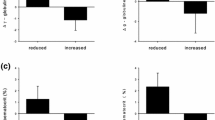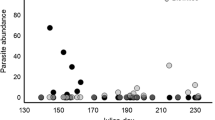Abstract
We measured the energy cost of ectoparasitism in an experimental study of the house martin bug Oeciacus hirundinis and its main host, nestlings of the house martin Delichon urbica. Nests were randomly assigned to inoculation with 0 (control) 10, or 100 bugs during egg laying, and this resulted in statistically significant differences in parasite loads following fledging of nestlings. Parasite loads negatively affected house martin nestlings as estimated from their body mass at age 16 days and from mass loss estimated over 1 day late in the nestling period. Daily energy expenditure (KJ/d), average daily metabolic rate (ml CO2/g h), and mass independent daily energy expenditure (kJ/mass0.67d) did not differ significantly between experimental treatments. However, average daily metabolic rate increased with increasing intensities of ectoparasitism. Mass independent daily energy expenditure also increased with higher levels of parasite infestation. These results demonstrate that the bug imposes an energy cost on its host by elevating the level of metabolism.
Similar content being viewed by others
References
Booth DT, Clayton DH, Block BA (1993) Experimental demonstration of the energetic cost of parasitism in free-ranging hosts. Proc R Soc Lond Ser B 253:125–129
Bryant DM (1989) Determination of respiration rates of free-living animals by the double-labelling technique. In: Grubb PJA, Whittaker JG, (eds) Towards a more exact ecology. Blackwell, Oxford, pp 85–109
Bryant DM, Gardiner A (1979) Energetics of growth in house martins (Delichon urbica). J Zool Lond 189:275–304
Connors VA, Nickol BB (1991) Effects of Plagiorhynchus cylindraceus (Acanthocephala) on the energy metablism of adult starlings, Sturnus vulgaris. Parasitology 103:395–402
de Lope F (1983) La avifauna de las Vegas Bajas del Guadiana. Doñana Acta Vert 10:91–121
de Lope F, González JJ, Møller AP (1993) Increased detrimental effects of ectoparasites on their bird hosts during adverse environmental conditions. Oecologia 95:234–240
Feltham M (1987) The energetics of nestling birds. Unpublished PhD Thesis, University of Stirling, Stirling, UK
Forbes MRL (1993) Parasitism and host reproductive effort. Oikos 67:444–450
Heusner AA (1985) Body size and energy metabolism. Annu Rev Nutr 5:267–293
Johnston RD (1993) Effects of diet quality on the nestling growth of a wild insectivorous passerine, the house martin Delichon urbica. Funct Ecol 7:255–266
Klaassen M, Masman D, Slagsvold G (1989) Growth and energetics of Arctic tern chicks (Sterna paradisea). Auk 106:240–248
Konarzewski M (1988) A model of growth in altricial birds based on changes in the water content of tissues. Ornis Scand 21:169–178
Lifson N, McClintock RM (1966) Theory of use of the turnover rates of body water for measuring energy and material balance. J Theor Biol 12:46–74
Møller AP (1990) Effects of an haematophagous mite on the barn swallow (Hirundo rustica): a test of the Hamilton and Zuk hypothesis. Evolution 44:771–784
Møller AP (1993) Parasites increase the cost of reproduction in their hosts. J Anin Ecol 62:309–322
Møller AP (1994a) Parasites as an environmental component of reproduction in birds. Ardea (in press)
Møller AP (1994b) Parasite infestation and parental care in the barn swallow Hirundo rustica: a test of the resource-provisioning model of parasite-mediated sexual selection. Ethology (in press)
Møller AP, Allander K, Dufva R (1990) Fitness effects of parasites on passerine birds: a review. In: Blondel J, Gosler A, Lebreton J-D, McCleery RH (eds) Population biology of passerine birds: an integrated approach. Springer, Berlin Heidelberg New York pp 269–280
Munger JC, Karasov WH (1989) Sublethal parasites and host energy budgets: tapeworm infection in white-footed mice. Ecology 70:904–921
Nagy KA (1980) CO2 production in animals: analysis of potential errors in the doubly-labelled water technique. Am J Physiol 238:466–473
Price PW (1980) Evolutionary biology of parasites. Princeton University Press, Princeton
Ricklefs RE (1974) Energetics of reproduction in birds. In: Paynter RA (ed) Avian energetics. Nuttall Ornithology Club Publication 15, pp 152–297
Schall JJ, Bennett AF, utnam RW (1982) Lizards infected with malaria: physiological and behavioral consequences. Science 217:1057–1059
Speakman JR (1994) How should we calculate CO2 production in doubly-labelled water studies of animals? Funct Ecol (in press)
Speakman JR, Racey PA (1989) The doubly-labelled water technique for measurement of energy expenditure in free-living animals. Sci Prog, 72:227–237
Weathers WW, Sullivan KA (1989) Juvenile foraging proficiency, parental effort, and avian reproductive success. Ecol Monogr 59:223–246
Weathers WW, Koenig WD, Stanback MT (1990) Breeding energetics and thermal ecology of the acorn woodpecker in central coastal California. Condor 92:341–359
Williams JB (1988) Field metabolism of tree swallows during the breeding season. Auk 105:706–714
Williams JB, Nagy KA (1985) Water flux and energetics of nestling savannah sparrows in the field. Physiol Zool 58:515–525
Author information
Authors and Affiliations
Rights and permissions
About this article
Cite this article
Møller, A.P., de Lope, F., Moreno, J. et al. Ectoparasites and host energetics: house martin bugs and house martin nestlings. Oecologia 98, 263–268 (1994). https://doi.org/10.1007/BF00324213
Received:
Accepted:
Issue Date:
DOI: https://doi.org/10.1007/BF00324213




